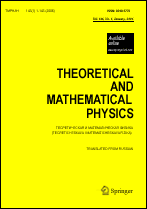|
Strong decays of the charmonium-like state Y(4230) and radiative transitions of low-lying charmoniums
G. Gandboldab
a Bogoliubov Laboratory of Theoretical Physics, Joint
Institute for Nuclear Research, Dubna, Moscow region, Russia
b Institute of Physics and Technology, Mongolian Academy of Sciences, Ulaanbaatar, Mongolia
Abstract:
The recently reported strong decays of the charmonium-like state Y(4230) by the BESIII collaboration and the dominant radiative transitions of the charmonium low-lying excited states are studied within a covariant quark model by involving the analytic confinement concept. The Y(4230) resonance is interpreted as a four-quark state of molecular type. We use the compositeness condition to eliminate any constituent degrees of freedom from the space of physical states and rigorously fix the renormalized couplings of the hadron states. The helicity amplitudes, or Lorentz structures, are used to express the gauge-invariant transition amplitudes of the processes under consideration. The fractional strong decay width of Y→J/ψ+f0(980) is calculated, as is the branching ratio of strong decays (via the f0(980) resonance) with hidden charms, B(Y→K+K−J/ψ)/B(Y→π+π−J/ψ), as measured by the BESIII Collaboration in 2022. Only one common adjustable parameter for the charmonium states ηc(1S0), J/ψ(3S1), χc0(3P0), χc1(3P1), hc(1P1), and χc2(3P2) is introduced to describe the quark distribution inside the hadron. We calculate the fractional widths of one-photon radiative decays for the states J/ψ(3S1), χcJ(3PJ), J={0,1,2}, and hc(1P1). Our estimates of the decay widths of the processes under consideration are in reasonable agreement with the latest experimental data.
Keywords:
relativistic quark model, confinement, exotic states, charmonium, tetraquarks, decay widths.
Received: 31.01.2023
Revised: 31.01.2023
Citation:
G. Gandbold, “Strong decays of the charmonium-like state Y(4230) and radiative transitions of low-lying charmoniums”, TMF, 216:3 (2023), 490–503; Theoret. and Math. Phys., 216:3 (2023), 1326–1336
Linking options:
https://www.mathnet.ru/eng/tmf10462https://doi.org/10.4213/tmf10462 https://www.mathnet.ru/eng/tmf/v216/i3/p490
|


| Statistics & downloads: |
| Abstract page: | 126 | | Full-text PDF : | 15 | | Russian version HTML: | 52 | | References: | 39 | | First page: | 17 |
|




 Contact us:
Contact us: Terms of Use
Terms of Use
 Registration to the website
Registration to the website Logotypes
Logotypes









 Citation in format
Citation in format 